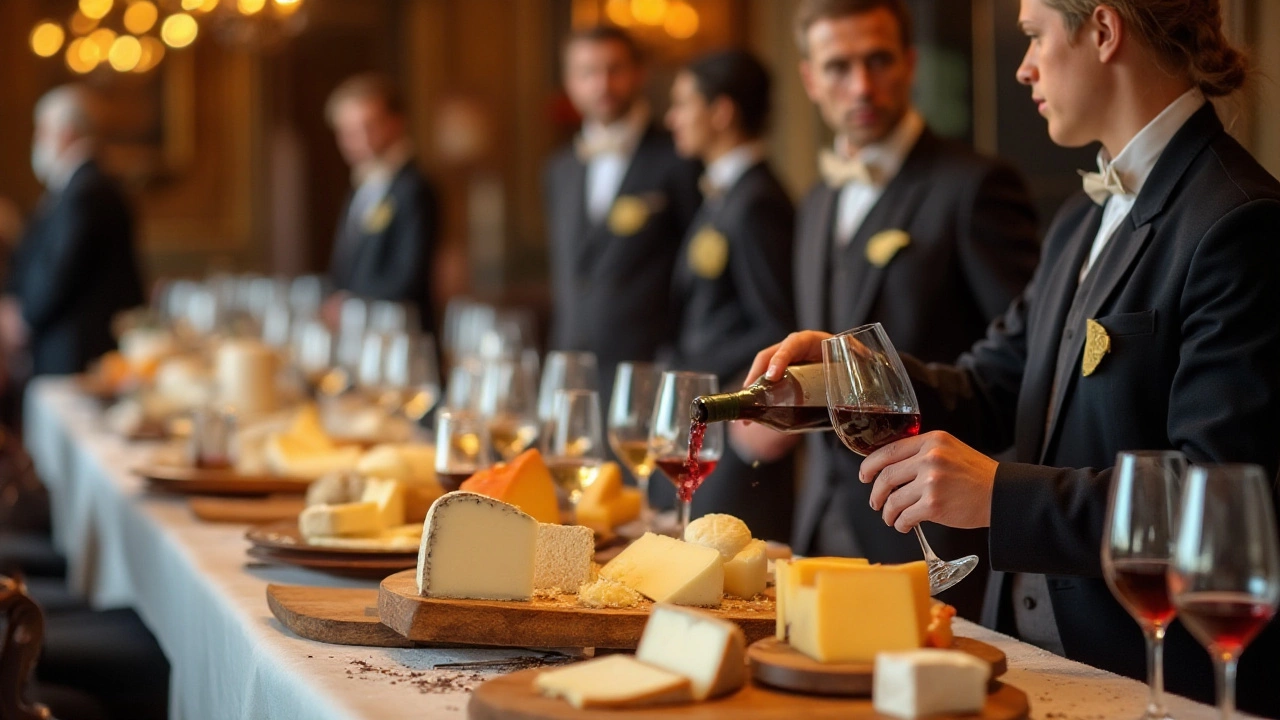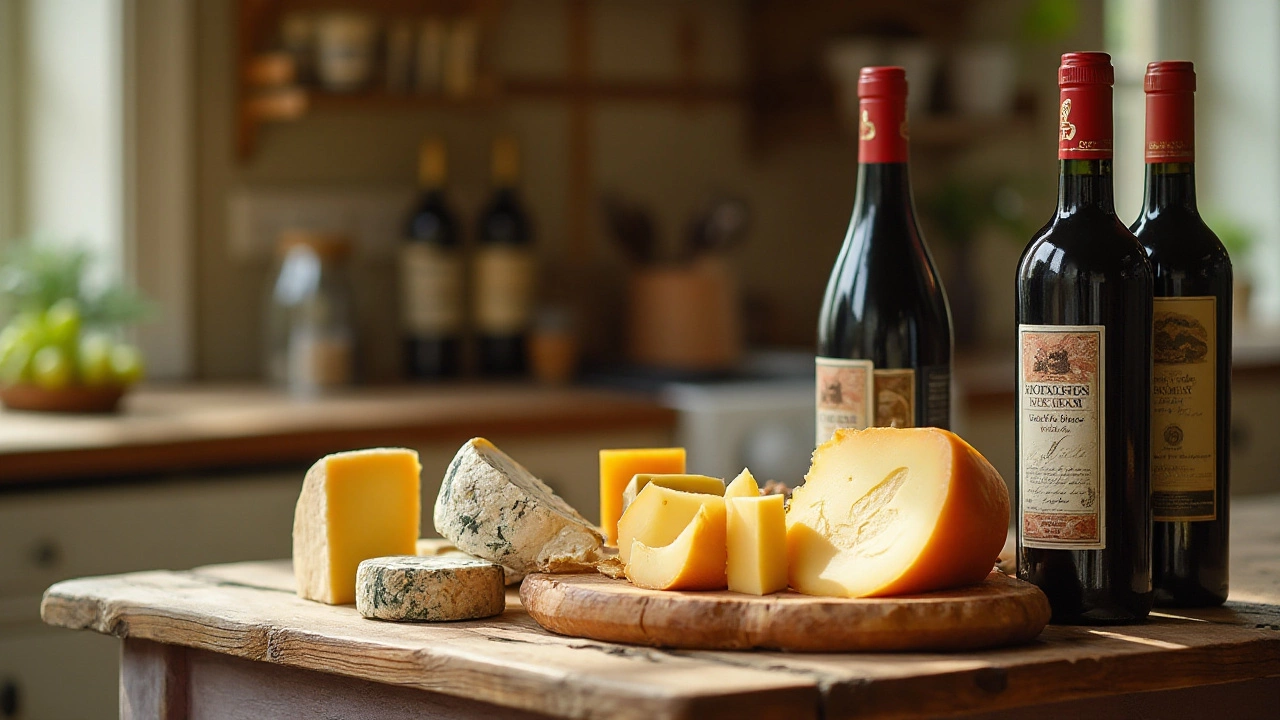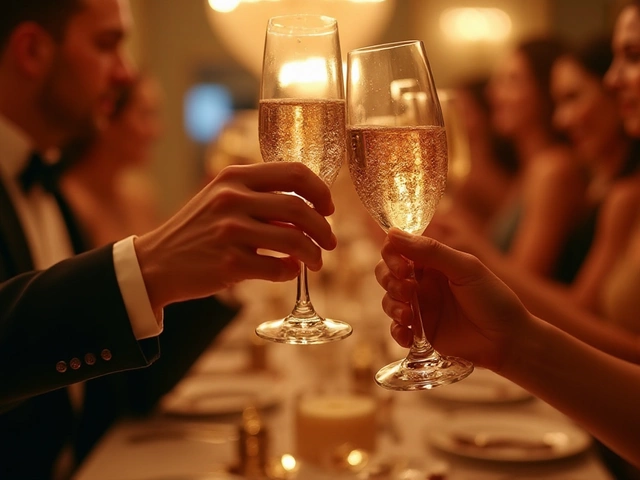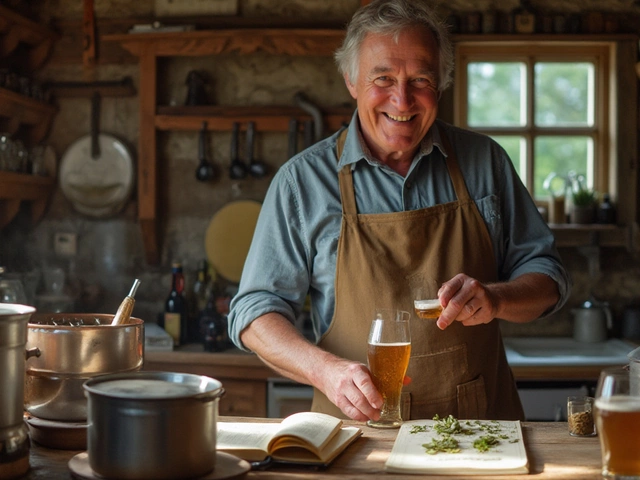Pairing wine and cheese is more than just a culinary tradition—it's an experience that can create harmony or contrast in flavors, sparking endless debates about the perfect order. For those passionate about crafting an exquisite taste journey, deciding whether to indulge in cheese or wine first plays a crucial role. Some say cheese should lead, allowing its creamy textures to prepare the palate, while others argue for wine's refreshing sip to set the stage for cheese's richness.
Dipping into both historical and modern pairing perspectives reveals fascinating insights into how flavors meld or clash. It's a delicate dance of balance, with the cheese's richness and wine's acidity often guiding the sequence. Whether you're hosting a tasting party or enjoying a quiet moment, knowing how to navigate these flavor dynamics can elevate your experience.
- The Art of Wine and Cheese Pairing
- Does Order Matter in Tasting?
- Exploring Traditional Pairing Wisdom
- Flavor Profiles and Pairing Success
- Contemporary Pairing Approaches
- Tips for a Personal Tasting Experience
The Art of Wine and Cheese Pairing
Embarking on a journey through the world of wine and cheese pairing can feel much like discovering a language spoken through taste. The symphony of aged cheeses and finely crafted wines dances across the palate, creating moments that tantalize both connoisseurs and casual fans. Each cheese possesses a unique personality, from the robust character of a blue cheese to the creamy elegance of a Brie, and every wine introduces its own symphony of flavors, from the crisp refreshment of a Chardonnay to the bold presence of a Cabernet Sauvignon. This complex interaction is what makes wine and cheese pairing an art form—an exploration of contrasts and complements that begins with understanding the individual traits of each element.
The art here lies not only in selecting harmonious flavors but also in challenging norms and experimenting with bold contrast. Traditional pairing wisdom suggests matching the intensity of both wine and cheese, meaning a strong cheese demands an equally robust wine. But rules are often meant to be broken, leading to modern pairings that delight in the opposing flavors, such as pairing sweet wines with salty cheeses to create unexpected alchemy on the tongue. This journey involves not just taste but also texture, as creamy cheeses meld with silky wines or crumbly cheeses provide a textural foil to a smooth sip.
According to many experts, the key to successful pairing often lies in one's willingness to listen to their senses. There's more than science at play; it is inherently personal, celebrating individual taste preferences. James Beard once eloquently noted, "Good bread and good wine and good cheese is one of life’s most perfect culinary combinations." This timeless pairing calls for mindful tasting—sampling the cheese first, then a sip of wine, and then enjoying the combination, gauging the interplay, modifying choices based on one's own reactions.
"Wine and cheese are ageless companions, like aspirin and aches, or June and moon, or good people and noble ventures," Clifton Fadiman aptly remarked, capturing the timeless essence of this pairing that has shaped countless cultural dinners worldwide.
For enthusiasts exploring the intricate dance between wine and cheese, it becomes crucial to understand that local pairings often yield delightful results, too. Regions known for specific wines typically have cheeses that complement them superbly. The lush Pinot Noir from Burgundy, for example, pairs beautifully with the region's creamy cheeses, showcasing an evolution of regional gastronomy that reflects hundreds of years of shared tradition. Additionally, understanding the impact of seasonal changes on both wine and cheese can open up new dimensions in pairing, as the flavors shift subtly with time, drawing fresh nuances from both elements.
Whether you're sipping a fine wine in the lush vineyards of France or enjoying a hearty cheese board in a cozy Sydney restaurant, the act of pairing wine with cheese is a timeless ritual that speaks to the soul. It invites discovery, not only through taste but through shared experiences, weaving stories of history, culture, and personal preference. Dive into this art with an open heart and palate, and you'll find a world rich with possibility and flavor waiting to be explored.
Does Order Matter in Tasting?
The tantalizing dance of wine pairing and cheese pairing is more than just a refined art; it's a charismatic balance of flavors and a sensory dialogue between taste and aroma. Many wine enthusiasts and cheese aficionados often debate whether to savor the wine before the cheese or vice versa. This seemingly simple choice can accentuate or mute certain flavors and aromas, crafting a whole new dimension in your tasting quest.
Without doubt, the sequence can have profound effects on how you experience taste. If cheese comes first, its creamy richness might coat the palate, creating a silken base that can either amplify or overshadow the wine's delicate notes. Conversely, beginning with wine can wash over the mouth, preparing it to embrace cheese's diverse textures and flavors. An incorrect order might result in the wine losing its character against a powerful cheese, or the cheese tasting flat after a bold sip of wine.
Paul Clarke, a renowned expert in culinary sciences, opines,
"The interplay between wine and cheese is nothing short of magical. The order in which they are tasted can turn a good pairing into an extraordinary one. Much like a well-rehearsed dance sequence, understanding when to lead and when to follow is essential."Understanding the chemistry behind this sequence is key. Wine and cheese both owe their flavors to complex aging processes. Cheese derives its tang from proteins and fats breaking down over time, while wine's variety comes from fermenting grapes. This makes each pairing unique, and consideration of which element should precede the other can transform your tasting journey.
An interesting perspective also lies in the regional practices of pairing. In some parts of France, it's customary to start with cheese as it sets a fatty canvas for the wine's acidity to play upon. In contrast, Italian traditions might lean towards cleansing the palate with wine first, allowing the diverse cheeses to take the spotlight. What emerges from these cultural nuances is a beautiful spectrum of possibilities - each method boasting its own merits and offering varied tasting experiences.
To delve deeper, try experimenting with both sequences yourself. Host a tasting session and consciously note the different sensations when starting with cheese versus wine. Keep a log of textures, flavors, and your personal preferences. This conscious tasting can cultivate an understanding of why such an order holds importance and can guide future pairings to achieve the symphony of flavors you desire.
At times, different environmental factors like temperature can also influence this dynamic. Cheese at room temperature, paired with a chilled wine, might alter the perception depending on the order. Having tools like these at your disposal and understanding their interplay can elevate any meal into a luxurious tasting experience.

Exploring Traditional Pairing Wisdom
The timeless tradition of pairing wine and cheese is rooted deeply in history, stretching back to ancient times when local vintners and cheesemakers naturally complemented each other. This synergy is not coincidence; rather, it's a convergence of geographical and cultural commonalities that have shaped these pairings over centuries. In France, for instance, the concept of terroir enhances the understanding that a cheese and a wine from the same region inherently match. Often, such pairings arise from the unique environmental factors influencing the flavor characteristics of both the cheese and wine, merging seamlessly in taste.
The classic pairing of wine and cheese has traditionally adhered to a simple rule: pair the intensity of the cheese with the robustness of the wine. Aged cheeses, like a savory Parmesan, tend to demand a bold, full-bodied wine such as a robust Cabernet Sauvignon, capable of matching its depth. This is predicated on the principle of neither component overpowering the other, maintaining a harmonious balance where both the wine and cheese can have their flavors appreciated fully. One often cited guideline is, 'what grows together, goes together,' suggesting that wines and cheeses hailing from the same region should naturally fit like pieces of a culinary puzzle.
An additional layer of traditional wisdom also concerns the sequence of tasting. In many cultures, it is typical to start with the cheese, allowing its creamy or sharp essence to prepare the palate for the wine's nuances. This method is believed to enhance the perception of the wine pairing, bringing out subtleties in the wine that might otherwise remain unnoticed. However, there is an equal voice advocating for commencing with the wine, allowing its tannins to form a base that complements the cheese’s rich flavors. This side of the debate offers a testament to the complexity and individuality of taste preferences.
Exploring the wealth of traditional guidance, one also recognizes that most classic pairings were born out of necessity rather than deliberate choice. For instance, in the Italian countryside, a Manchego might be paired with a local rioja, not out of a gastronomic formula, but both were produced locally and consumed as part of daily life. The utilitarian aspect of traditional pairings has subtly informed the elaborate guidelines observed today.
As Julia Child eloquently put it, "Wine is meant to be enjoyed with good friends and good food." This reflects the age-old adage that the best pairings are ultimately decided by individual preference and shared joy. Traditional wisdom serves as a guidepost, a canvas upon which personal taste can be painted vividly, blending the old with the new to create an unparalleled flavor experience.
Flavor Profiles and Pairing Success
When it comes to achieving an awe-inspiring synergy between wine and cheese, understanding flavor profiles is pivotal. The essence of a well-thought-out pairing lies in recognizing how varying characteristics like sweetness, acidity, richness, and textures can complement or counteract each other. A creamy Camembert can meet its match in a sparkling wine, where the bubbles cut through the cheese's luscious texture, lifting its rich flavors to greater heights. Meanwhile, a robust red wine with its deep tannins may find its soulmate in the strong and salty personalities of aged Cheddar or Gouda. Here, the interplay is about contrast as much as it is about harmony, where each sip and bite tells a new story.
Venturing into the specifics, one might consider the notable classification of cheese—fresh, bloomy, washed rind, blue, and hard, among others—to determine ideal pairings. For instance, fresh cheeses like ricotta sing when partnered with a light and zesty Sauvignon Blanc. The wine's citrus notes enhance the cheese's delicate creaminess, creating an effortless balance. Similarly, a bloomy rind cheese such as Brie mirrors the rich, buttery flavors of a Chardonnay, each sip enveloping the palate in luxurious warmth.
Alice Feiring, a renowned wine journalist, once remarked, "Wine and cheese pairing isn't about rules; it's an adventure with flavors as your guide."Such expertise tells us to not fear experimentation; even the most unorthodox pairings may surprise and delight.
On the flip side, understanding certain wine pairing pitfalls is crucial. A tannic wine paired with a soft cheese might overwhelm the palate, overshadowing subtle nuances. Instead, each selection should strive for equilibrium, enhancing flavors while maintaining their individuality. To aid in decision-making, consider a fundamental rule: match intensity with intensity. A powerful blue cheese, notorious for its pungency, pairs splendidly with a sweet dessert wine like Port. In this dance of flavors, sweetness tempers the strong salty nature of blue cheese, delivering a balanced experience. Such pairings invite an awareness of flavors, encouraging a sensory exploration that adds depth to the enjoyment of cheese pairing.
For those seeking guidance, consider keeping a table of matches handy, akin to a cheat sheet for your taste buds:
| Cheese Type | Recommended Wine |
|---|---|
| Fresh (Mozzarella) | Prosecco |
| Bloomy Rind (Camembert) | Champagne |
| Hard (Parmigiano-Reggiano) | Bordeaux |
| Blue (Stilton) | Port |
This methodical yet open-minded approach empowers the wine and cheese aficionado to delve deeper into tastings with confidence. Such frameworks are invaluable when experimenting with new and unique pairings beyond the traditional boundaries. Embrace the journey, for it's where the magic truly happens, as you uncover your personal favorites amongst the classic and contemporary pairings available to every curious palate.

Contemporary Pairing Approaches
In today's ever-evolving culinary world, the art of pairing wine and cheese has undergone a dynamic transformation. The old adage of 'what grows together goes together' still holds value, but modern palates are often on a quest for more adventurous pairings that challenge traditional conventions. This can be both exciting and empowering as it allows for personal tastes and preferences to take center stage. The exploration of flavors often blends cultural insights with emerging trends, delving into new ingredients and production techniques which continue to enrich the tasting landscape. It's about embracing not just the pairing itself but the stories and experiences that these combinations evoke.
Consider, for instance, the innovative approach of matching bold, spicy cheeses with equally robust wines, like a rich Shiraz or a dynamic Zinfandel. This boldness meets boldness pairing style doesn't shy away from intensifying flavors on the tongue; rather, it celebrates them in an audacious dance of spice and savor. The practice of defying norms by marrying sweet and savory elements, such as a creamy blue cheese with a sweet Riesling, is a testimony to the creativity of the modern gourmet.
The influence of global cuisines also plays an important role in contemporary approaches. As gastronomic boundaries blur, so do those of cheese pairing. Flavors from across the world are brought to local tables, allowing fusion pairings like goat cheese with sake or smoked cheeses with exotic fruit wines. These pairings introduce a spectrum of unexpected flavors, creating memorable tasting experiences that are a departure from the routine. The experimentation with natural and organic cheese and wines offer a healthier spin, highlighting terroir and environmental consciousness.
Mario Batali once said, "When finding the right cheese and wine pairing, it's more about understanding the harmony they create together rather than following rigid rules." His words underscore a vital modern ethos in the cheese and wine community: rules are guideposts, not fences. It's an invitation to freely explore taste preferences, resulting in unexpected pairings that harmonize beautifully.
Creating Unique Pairings at Home
For enthusiasts eager to explore wine and cheese on a deeper level, creating unique pairings at home can be a delightful journey. Begin by assembling a selection of diverse cheeses and wines. Including both ends of the spectrum—mild to strong, light to full-bodied—offers a broader canvas for artistic exploration. Pair soft cheeses with crisp, acidic wines to make each flavor sing distinctively, or venture into crafting surprises by pairing salty cheeses with dessert wines. These modern pairings embrace freedom and self-discovery, fostering a new appreciation for both wine and cheese.
Tips for a Personal Tasting Experience
Crafting a personal wine and cheese tasting experience is like painting your own masterpiece; there are guidelines you can follow, yet the true beauty lies in the moments of spontaneity and discovery. To kick off this flavorful journey, it helps to first understand your palate's preferences. Start by reflecting on whether you usually gravitate towards sharp and robust cheeses or lean towards those with a milder, creamier profile. Similarly, note if you prefer a wine that dances on the lighter, fruitier side or one with a full-bodied, tannic embrace. Knowing this, the exploration becomes a delightful experiment with no wrong answers.
Once you have a general sense of what you enjoy, consider creating a tasting sequence. Many enthusiasts find joy in beginning with milder options—like a white wine such as Sauvignon Blanc paired with a soft cheese like Brie—luxuriating in the subtleties before stepping incrementally towards more intense flavors. This gradual exploration allows the cheese pairing to shine through progressively complex layers of taste.
According to wine expert Karen MacNeil, "Understanding your taste preferences is empowering. You're the director of this experience, so let your palate lead the way."
Keep in mind the concept of complement and contrast. For each wine pairing, perhaps opt for a contrasting cheese and vice versa. A salty blue cheese can beautifully contrast with the sweetness of a rich Port, creating a symphony of flavors that surprise but satisfy. On the flip side, a nutty Comté with a similarly nutty Chardonnay can provide a complementary pairing that seamlessly blends into a delightful warm experience. The key is to savor each bite and sip, paying close attention to how both wine and cheese unfold on your palate.
Engaging all senses can elevate the overall experience to dizzying heights of pleasure. As you swirl, sniff, and savor your wine, let its aroma mingle with the cheese's scent. Notice the different textures on your tongue and how they interact. Combining sight, smell, taste, and even sound creates a multi-sensory celebration. Remember, there are no mistakes in personal wine and cheese pairing; it's as much about enjoying the journey as it is about reaching a harmonious destination.
For those who like a bit more structure in their adventure, jot down observations in a tasting notebook. Rate how well a particular cheese with a specific wine pairing resonated with you. Did the wine overpower the cheese, or did they dance in perfect harmony? Such notes may reveal patterns, helping hone in on the types of pairings that bring you the most joy. Over time, these insights can become the foundation for hosting delightful tasting parties or simply enriching your culinary routine.
Finally, embrace the company of others in your tasting experience. Sharing thoughts and opinions with friends can introduce new perspectives and flavors you might not have considered otherwise. Encourage open conversations, try blind pairings, and bask in the collective joy of discovering perfect combinations. Whether you're a novice or a seasoned enthusiast, treating yourself to a wine and cheese journey is a rewarding, ongoing exploration of taste.


